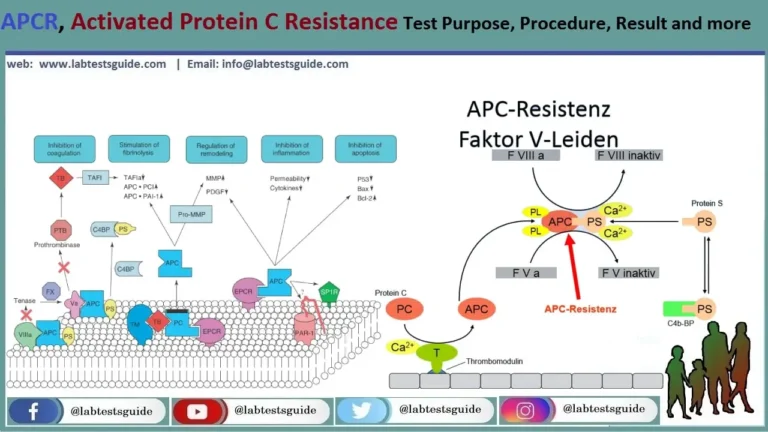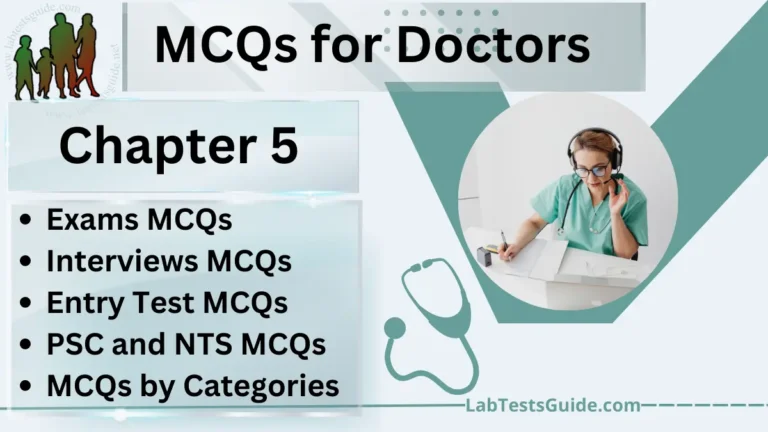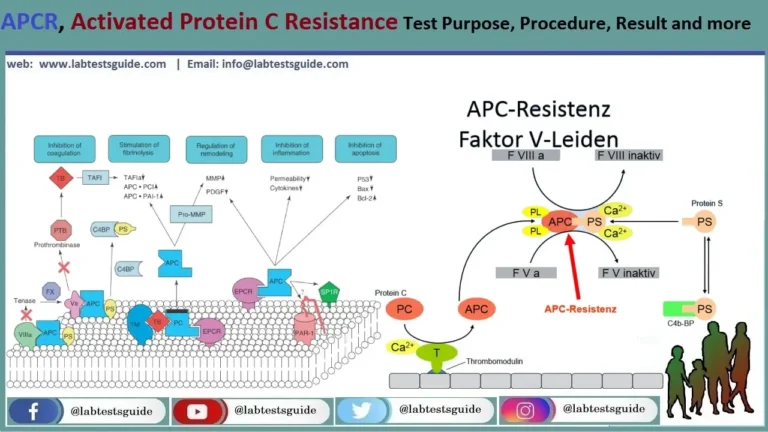4601 to 4650 MCQs for Lab Technician and Technologist Exam Preparation
5000 Plus MCQs for Lab Technician and Technologists are designed to test the knowledge and proficiency of laboratory professionals who work in the field of clinical laboratory science. These questions cover a wide range of topics related to laboratory science, including anatomy, physiology, microbiology, chemistry, and hematology.

If You like then share this to your friends and other social media.
If You have any question and suggestions then please Contact us Here
Questions 4601 to 4650
- The most important epimer of glucose is
- Galactose✔
- Fructose
- Arabinose
- Xylose
- α-D-glucose and β -D-glucose are
- Stereoisomers
- Epimers
- Anomers✔
- Keto-aldo pairs
- α-D-glucose + 1120→ + 52.50 ← + 190 βD-glucose for glucose above represents
- Optical isomerism
- Mutarotation✔
- Epimerisation
- D and L isomerism
- Compounds having the same structural formula but differing in spatial configuration are known as
- Stereoisomers✔
- Anomers
- Optical isomers
- Epimers
- In glucose the orientation of the —H and —OH groups around the carbon atom 5 adjacent to the terminal primary alcohol carbon determines
- D or L series✔
- Dextro or levorotatory
- α and β anomers
- Epimers
- The carbohydrate of the blood group substances is
- Sucrose
- Fucose✔
- Arabinose
- Maltose
- Erythromycin contains
- Dimethyl amino sugar✔
- Trimethyl amino sugar
- Sterol and sugar
- Glycerol and sugar
- A sugar alcohol is
- Mannitol✔
- Trehalose
- Xylulose
- Arabinose
- The major sugar of insect hemolymph is
- Glycogen
- Pectin
- Trehalose✔
- Sucrose
- The sugar found in DNA is
- Xylose
- Ribose
- Deoxyribose✔
- Ribulose
- The sugar found in RNA is
- Ribose✔
- Deoxyribose
- Ribulose
- Erythrose
- The sugar found in milk is
- Galactose
- Glucose
- Fructose
- Lactose✔
- Invert sugar is
- Lactose
- Sucrose
- Hydrolytic products of sucrose✔
- Fructose
- Sucrose consists of
- Glucose + glucose
- Glucose + fructose✔
- Glucose + galactose
- Glucose + mannose
- The monosaccharide units are linked by 1 → 4 glycosidic linkage in
- Maltose✔
- Sucrose
- Cellulose
- Cellobiose
- Which of the following is a non-reducing sugar?
- Isomaltose
- Maltose
- Lactose
- Trehalose✔
- Which of the following is a reducing sugar?
- Sucrose
- Trehalose
- Isomaltose✔
- Agar
- A dissaccharide formed by 1,1-glycosidic linkage between their monosaccharide units is
- Lactose
- Maltose
- Trehalose✔
- Sucrose
- Mutarotation refers to change in
- pH
- Optical rotation✔
- Conductance
- Chemical properties
- A polysacchharide which is often called animal starch is
- Glycogen✔
- Starch
- Inulin
- Dextrin
- A carbohydrate, commonly known as dextrose is
- Dextrin
- D-Fructose
- D-Glucose✔
- Glycogen
- The polysaccharide used in assessing the glomerular fittration rate (GFR) is
- Glycogen
- Agar
- Inulin✔
- Hyaluronic acid
- The constituent unit of inulin is
- Glucose
- Fructose✔
- Mannose
- Galactose
- The po lysacchar ide found in the exoskeleton of invertebrates is
- Pectin
- Chitin✔
- Cellulose
- Chondroitin sulphate
- Which of the following is a heteroglycan?
- Dextrins
- Agar✔
- Inulin
- Chitin
- The glycosaminoglycan which does not contain uronic acid is
- Dermatan sulphate
- Chondroitin sulphate
- Keratan sulphate✔
- Heparan sulphate
- Keratan sulphate is found in abundance in
- Heart muscle
- Liver
- Adrenal cortex
- Cornea✔
- Repeating units of hyaluronic acid are
- N-acetyl glucosamine and D-glucuronic acid✔
- N-acetyl galactosamine and D-glucuronic acid
- N-acetyl glucosamine and galactose
- N-acetyl galactosamine and L- iduronic acid
- The approximate number of branches in amylopectin is
- 10
- 20✔
- 40
- 80
- In amylopectin the intervals of glucose units of each branch is
- 10–20
- 24–30✔
- 30–40
- 40–50
- A polymer of glucose synthesized by the action of leuconostoc mesenteroids in a sucrose medium is
- Dextrans
- Dextrin
- Limit dextrin
- Inulin✔
- Glucose on reduction with sodium amalgam forms
- Dulcitol
- Sorbitol✔
- Mannitol
- Mannitol and sorbitol
- Glucose on oxidation does not give
- Glycoside✔
- Glucosaccharic acid
- Gluconic acid
- Glucuronic acid
- Oxidation of galactose with conc HNO3 yields
- Mucic acid✔
- Glucuronic acid
- Saccharic acid
- Gluconic acid
- A positive Benedict’s test is not given by
- Sucrose✔
- Lactose
- Maltose
- Glucose
- Starch is a
- Polysaccharide✔
- Monosaccharide
- Disaccharide
- None of these
- A positive Seliwanoff’s test is obtained with
- Glucose
- Fructose✔
- Lactose
- Maltose
- Osazones are not formed with the
- Glucose
- Fructose
- Sucrose✔
- Lactose
- The most abundant carbohydrate found in nature is
- Starch
- Glycogen
- Cellulose✔
- Chitin
- A carbohydrate found only in milk is
- Glucose
- Galactose
- Lactose✔
- Maltose
- An early feature of renal disease is
- Impairment of the capacity of the tubule to perform osmotic work✔
- Decrease in maximal tubular excretory capacity
- Decrease in filtration factor
- Decrease in renal plasma flow
- ADH test is based on the measurement of
- Specific gravity of urine✔
- Concentration of urea in urine
- Concentration of urea in blood
- Volume of urine in ml/minute
- The specific gravity of urine normally ranges from
- 0.900–0.999
- 1.003–1.030✔
- 1.000–1.001
- 1.101–1.120
- Specific gravity of urine increases in
- Diabetes mellitus✔
- Chronic glomerulonephritis
- Compulsive polydypsia
- Hypercalcemia
- Fixation of specific gravity of urine to 1.010 is found in
- Diabetes insipidus✔
- Compulsive polydypsia
- Cystinosis
- Chronic glomerulonephritis
- Maltose can be formed by hydrolysis of
- Starch
- Dextrin
- Glycogen
- All of these✔
- Number of stereoisomers of glucose is
- 4
- 8
- 16✔
- None of these
- Fructose is present in hydrolysate of
- Sucrose
- Inulin
- Both of the above✔
- None of these
- A carbohydrate found in DNA is
- Ribose
- Deoxyribose✔
- Ribulose
- All of these
- Ribulose is a these
- Ketotetrose
- Aldotetrose
- Ketopentose✔
- Aldopentose
The questions are typically designed to assess the technical skills and knowledge required for the laboratory profession, including the ability to analyze laboratory test results, perform laboratory procedures, and maintain laboratory equipment.
To prepare for these MCQs, candidates should have a thorough understanding of the key concepts and principles of laboratory science. They should also be familiar with common laboratory equipment and procedures, as well as laboratory safety protocols.
Candidates may also benefit from studying specific laboratory science textbooks or taking online courses that cover the material tested in the MCQs. Additionally, practicing sample MCQs and reviewing the answers can help candidates identify areas where they may need to improve their knowledge or skills.
Overall, the MCQs for lab technologists are designed to be challenging and comprehensive, requiring candidates to demonstrate a high level of proficiency in the field of laboratory science.
Possible References Used







